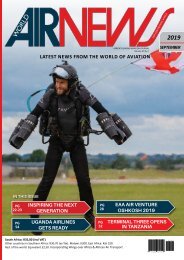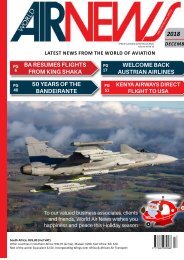World AirNews June 2018
- No tags were found...
You also want an ePaper? Increase the reach of your titles
YUMPU automatically turns print PDFs into web optimized ePapers that Google loves.
NEWS DIGITAL<br />
NEWS DIGITAL<br />
thing from missile-lock technology on fighter jets to seatbelt light<br />
activations on Boeing 737s,” Rombouts proudly stated. “I’ve been<br />
at Belgium Campus for almost twenty years now and we all truly<br />
believe that bright minds thrive best when offered the space in<br />
which to create. That’s why we’ve constructed physical innovation<br />
spaces called ‘Learning Factories’. Here, our students are given the<br />
space and tools to take their ideas from prototype to marketplace,<br />
and this is a key focus for us in <strong>2018</strong>.”<br />
INNOVATION IS A DRIVER<br />
The South African general aviation market is extremely small<br />
compared with the world leaders like United States and China,<br />
which are currently the world’s fastest growing in this segment.<br />
That said, the Aeronautics Project focuses on airspace as a<br />
platform for commercial and social innovation.<br />
“The aircraft we are building is purely experimental, as general<br />
aviation regulations prohibit modifications to certified aircraft.<br />
Within two years, the aircraft will take off and land on its own, but<br />
due to its size, legislation in South Africa insists a pilot needs to be<br />
inside the cockpit,” Rombouts explained.<br />
“One of the biggest hurdles to innovation in this sector are regulations.<br />
In truth, there are some technological hurdles to overcome<br />
before this vision of next-generation aviation comes to realisation,<br />
but regulations and extremely expensive certification processes<br />
can set innovation and reform back years, especially for start-ups<br />
and SMEs.”<br />
The aircraft is a thing of beauty and something to marvel. The<br />
team showed me each component, explaining the improvements<br />
they have developed and, of course, the impressive list of innovations<br />
any future technologist would be proud to have developed.<br />
The fuselage, they explained, was imported from the United<br />
States, due mainly to its aerodynamic shape for speed and safety.<br />
“Canard Pusher aircraft have an inherent safety advantage since<br />
they are insusceptible to loss of control from stalls and spins,” I am<br />
told.<br />
“And this ‘plane we are building will push small aircraft speed<br />
limits beyond the conventional 120km/h to 400km/h, so performance<br />
and safety need to go hand in hand.”<br />
Months of research were dedicated to aircraft engine performance<br />
and a Belgian engine was flown in to meet their requirements.<br />
The propeller originates from New Zealand, although the<br />
glass cockpit is a proudly South African component designed and<br />
manufactured in Stellenbosch by MGL Avionics.<br />
They explained that they chose MGL’s cockpit particularly, because<br />
it is an open-source system which gives them the freedom to<br />
develop further on what is existing.<br />
HIGH MORTALITY RATES<br />
Rombouts, an aviator himself<br />
with 40 years of experience,<br />
points to the dire need for<br />
innovation in general aviation,<br />
namely fuel efficiency and<br />
safety above all else.<br />
“In an age of technology and<br />
advancement, it is troubling<br />
to accept that most of the<br />
hobbyist and sport aircraft are<br />
basically unchanged from the<br />
models first introduced in the<br />
early fifties.”<br />
In the heart of the Belgium<br />
Campus Learning Factory,<br />
students are now focusing on<br />
making private flight safer by<br />
addressing one of the biggest<br />
categories of accidents: loss of<br />
control.<br />
Compared to commercial<br />
‘planes, private aircraft lack<br />
safety features and redundancies,<br />
including co-pilots,<br />
backup systems for navigation<br />
information and extra engines.<br />
“A lot of people think<br />
innovation is creating something<br />
new,” Rombouts added. “When often innovation is, in fact,<br />
combining existing things and giving them a new purpose. Yes, we<br />
developed new software, but the components we are using are<br />
already existing in other industries.<br />
“Everything that you can create to reduce the workload of the<br />
pilot immediately increases their safety,” he said, adding: “For<br />
example, between 10 000 and 12 000 feet, there are limitations on<br />
flight time before you require oxygen. Above 12 000 feet you will<br />
require oxygen and/or a pressurised cabin.”<br />
One of the young students added that, although in theory, this<br />
was the norm, the reality was that there were private pilots who<br />
had lung conditions like asthma or they had severe lung damage<br />
from smoking, and something as minor as flying at 8 000 feet could<br />
have devastating consequences.<br />
At An eArlier occAsion Belgium cAmpus students pArtnered with penn<br />
stAte university to work on innovAtive projects Aligned to mechAnicAl<br />
And electricAl engineering<br />
According to aviation statistics, every year there are more than<br />
1 000 accidents globally due to pilots passing out from a lack of<br />
oxygen. “There is no way of knowing as it happens so quickly and<br />
in seconds the plane no longer has a pilot in control. So, with the<br />
students, we thought, there has to be a solution to this as most private<br />
pilots don’t have a co-pilot with them,” Rombouts explained.<br />
The Aeronautics Project is currently engaged in developing<br />
affordable components that can be used by anyone, ultimately<br />
increasing safety in the cockpit for the general aviation sector.<br />
“As a pilot, I know the risks at play with aviation, but what<br />
troubles me are the statistics. General aviation flights are 82 times<br />
riskier than commercial airline trips.<br />
“This needs to be addressed across the industry. The technology<br />
is there, and this is why we are trying to make it more affordable<br />
and readily available.”<br />
<strong>World</strong> Airnews | <strong>June</strong> Extra <strong>2018</strong><br />
— 13 —<br />
<strong>World</strong> Airnews | <strong>June</strong> Extra <strong>2018</strong><br />
— 14 —





